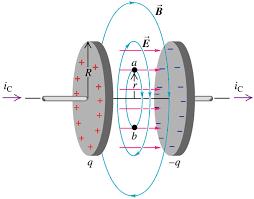In a capacitor, we always have a Displacement Current and never a Conduction Current under normal conditions i.e. when we apply a potential difference across a Capacitor which is below its specified maximum Voltage.
Capacitor contains an insulating material called dielectric sandwiched between two conductors. Since insulators can carry only an electric field but not moving carriers, therefore normally Capacitor has Displacement Current.
However, if we apply a huge voltage across a Capacitor, it behaves differently. Under sufficiently large potential differences, many insulators stop insulating i.e. they conduct electricity. So if we apply a large voltage beyond the specified limit, the dielectric behaves as a conductor. So we get conduction current in the capacitor. This happens just like a lightning strike, when the potential difference between the clouds and the earth becomes so large, that the atmosphere is forced to conduct and the electric flash strikes the ground. This is called breaking down of a capacitor.
When a capacitor breaks down, it no longer carries displacement current. Because it’s now a conductor! So, just like any other conductor, the electric field inside it is zero, and so is the displacement current.
